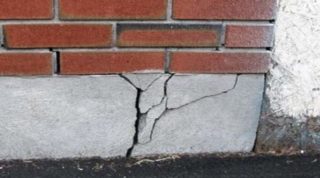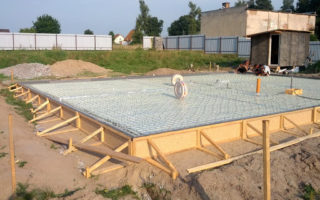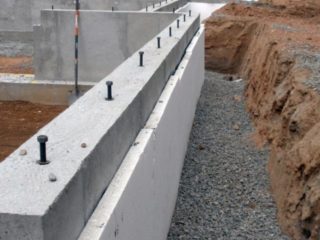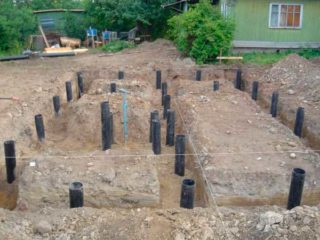If it is decided to build a foundation on clay soil, it is necessary to take into account its tendency to heave and not forget about measures that can neutralize its influence on the building. Such soils are among the most demanding.
Characteristics of clay soil

To decide what foundation to make on clay soil, you need to have an idea of its features that affect the operational characteristics of the buildings being built. The main difficulty lies in the tendency of clay to uneven heaving. Clay particles are abundantly impregnated with the incoming liquid. This can be sewage or groundwater, sediment, or other sources of moisture. When the soil freezes out in the cold season, the volume of the liquid contained in it increases by almost 10%. This leads to the tendency of the soil to push or tilt the reinforced concrete configurations. The nature of destruction of structures depends on the places of application of the force.
Moisture and low temperatures are responsible for the destructive processes associated with swelling. Without these two factors, the described process will not begin, regardless of the composition of the soil. The greatest danger is posed by water, to the increased absorption of which clay soils are prone.
Varieties of clay soil

Soils are classified by the percentage of clay content. If its share is 0.05-0.1, such soil is called sandy loam. Soils with 10-20% of this component are classified as loamy. Such a composition already imposes restrictions related to taking into account the tendency to heaving. For example, a columnar foundation on loam, especially not equipped with a grillage, will be unreliable. As with other types of soils, its swelling in winter is influenced by the level of water occurrence. Clay-rich soils are considered to have more than 30% of it. They absorb a lot of moisture.
It is definitely not necessary to build a house on plastic clay located in a lowland near a reservoir. If there is no other option and you have to erect a building on such soil, piles are used to equip the base.
Glacial clay is more suitable in terms of its qualities for residential buildings, subject to careful adherence to building codes.
Features of the construction of the foundation
Measures specific to this type of soil are aimed at preventing frost swelling. It is often practiced to remove the top layer of the earth at the site of the future foundation. It is replaced with a mixture of sand and gravel. The thickness of such a pillow can be 0.4-0.8 m. In areas characterized by a high rise of groundwater, an abundance of precipitation or other sources of moisture, such a structure must be equipped with a drainage system. It consists of corrugated perforated pipes that drain fluid into the ground.
If a slab or tape is selected for the base, it is also possible to reduce heaving by insulating the blind area and basement. Backfilling with the mixture used for the pillow is also practiced. It neutralizes the pull-out forces arising from oblique loads on the sides of the foundation components.
Preparatory work

When planning to build a house or an extension, you need to study the characteristics of the soil - its composition, the area of occurrence of groundwater, the slope of the terrain, the level of freezing.
To determine how much the soil on the site is rich in clay, you can do simple manipulations: try to roll one piece of earth into a tourniquet, and make a ball out of the other and squeeze it with your fingers. Sandy loam soils do not lend themselves to such operations in principle. When you try to mold something out of them, only unstable crumbling lumps appear. The loam plait turns out to be massive (1 cm thick or more). If a ball is made from such soil and squeezed, small cracks will appear on it. The clay rope comes out thin. As a rule, when the ball is squeezed, no cracks appear on it.
Recommendations for choosing a foundation

To decide which foundation is best made on loam or clay, you need to take into account the tendency to heaving, the location of groundwater, the evenness of the site, the estimated mass of the building. A heavy brick house requires more load-bearing capacity than a wooden one or built from aerated concrete blocks.
Shallow
From shallow structures, a monolithic slab is suitable for clay soil. Due to the large support area, it copes well with the phenomena of heaving, erosion of the earth. Such a base is suitable for both light frame houses and more massive buildings, however, additional work will be required to organize the basement. The foundation is arranged on a pillow of sufficient thickness (0.7-0.8 m) and equipped with an annular drainage system made of a corrugated pipe with cracks. The blind area is insulated to a width of 60-120 cm. Do not forget about waterproofing, especially if the walls are built of aerated concrete or other porous material.
Tape base

On such a foundation, you can build a one-story house and equip a basement. The structure should be well buried (below the freezing level) and wide enough (minimum - 0.5-0.6 m). The litter is made of small thickness - 0.2-0.4 m, backfilling - at least 0.4 m on each side. The sinuses of the pit are filled with a sand-crushed stone mixture. Slit strips are completely unsuitable for clay, the recessed areas of which are poured into the earthen formwork.
Pile
A pile grillage foundation on clay will be the best option: in this case, the supports, passing through the unstable soil layer, rest on a solid foundation. If bored elements with polyethylene formwork are chosen, a larger number of them will be required than when building on a more "convenient" soil, since the bearing qualities in this situation are reduced. Screw piles are also good.
If the grillage structure has a hanging shape, it will not work to organize heating of the soil under the building.
Construction stages

Before starting construction, you need to find out how many piles are required for the foundation. Support elements are installed at the corners of the building and in areas where the outer wall intersects with the inner one. Additional piles are placed along the long sides of the house. The distance between the supports should be 2 meters.
It is best to equip the building on clay soil on screw piles. They are reliable, have good load-bearing qualities, and are suitable for peat, swampy and other wet problem soils.
Sequence of work:
- The site is cleared of vegetation and the topsoil rich in organic compounds is removed.
- Make a markup. At this stage, you need to designate the places where the supports will be mounted.
- Then they begin to screw the piles. To do this, you will need to purchase special equipment. The vertical position is controlled by the building level.The lower parts of the supports should be below the freezing point and the area where groundwater is located. If the pile is too short to achieve this goal, it can be extended.
- The tops of the datum elements are aligned so that they are flush. To make the structure stronger, the piles can be concreted from the inside.
- Go to the arrangement of the grillage. It can be designed as a concrete strip with wooden formwork. The structure integrates the base supports into a single system.
The problem of clayey soils is associated with the tendency to absorb a lot of moisture, as a result of which the phenomenon of heaving is observed in winter. When building on such soils, you need to take care of measures to neutralize this effect.








